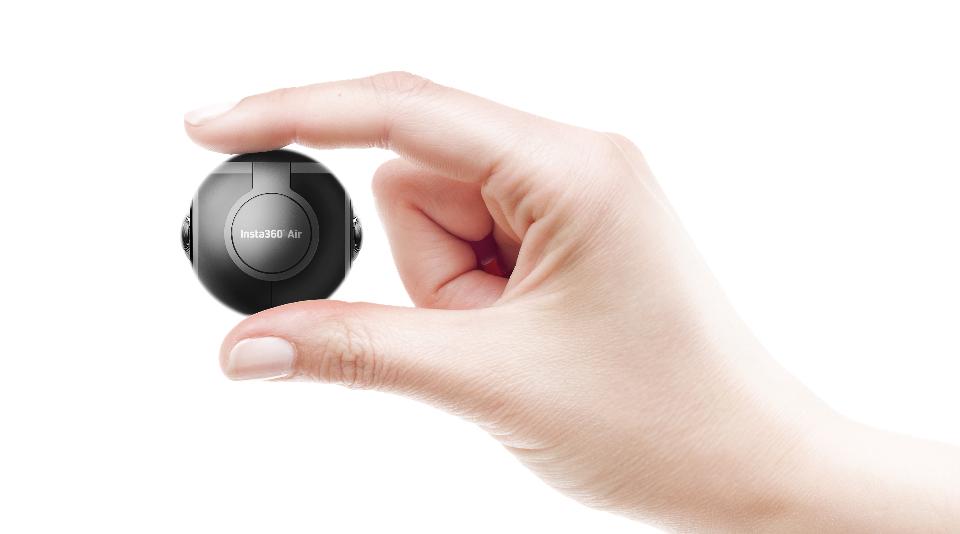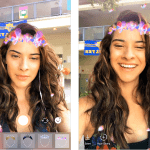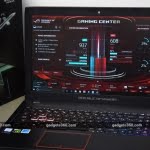
Insta360
The tiny Insta360 AIr
The Insta360 Air is a fantastic budget 360 camera. The Ricoh Theta S is the best all-around 360 camera. Their price tags are very different, but how the work is pretty similar: both offer an easy way to get good-looking 360 photos and videos.
Here’s how they compare head-to-head.
Before you start, check out my full reviews of the Ricoh Theta S and Insta360 Air.
Price
I think this is the important one to start with, as it offers a bit of a caveat to the rest of the discussion. All other pros and cons aside, the Insta360 Air is only $130. The Theta S is $300. That’s a sizable difference. If the Ricoh is worth 2.5x is what we’ll have a look at here.
Hardware
Physically these two couldn’t be more different. They barely look like cameras. The Insta360 is about the size of a golf ball. There are no controls, just a USB plug. It comes with a silicone sleeve to keep the lenses safe while you carry it. It’s a little odd in your pocket, but thanks to the clever sleeve you can throw it in a backpack or purse and not worry about it.
The Theta S is much larger, about half the width of your average smartphone, but about the same length and a bit thicker. There are a few buttons and lights to indicate mode and WiFi connection. A shutter button lets you take a quick photo or video without having to connect to your phone. Its size makes it easy to hold and slide in a pocket. Most importantly, you can mount it to a tripod.

Ricoh
The Ricoh Theta S
Honestly, this category is a bit of a wash. Yes, the Air is much smaller, but it’s not like the Theta S is bulky. It’s a lot more likely you’ll throw the Air in your bag “just to have it” where the Theta is more a conscious “we’re going to use this today.” The lenses on the Theta stick out, and the included neoprene sleeve doesn’t offer much protection.
It’s easier to hold the Theta above your head to take a picture with one hand (instead of juggling your phone up there and tapping the screen with your thumb). This may not seem like a big deal, but the first time your phone wobbles while you’re trying to take a photo with the Air, you’ll be very consciously aware of the precariousness.
Photos
Forbes doesn’t allow embedding of 360 photos yet (few websites do), so to see these in their full 360 glory, check out my Flickr page (most 360 photos there are with the Theta, the newer ones are both and are labeled).
What you see here are the stretched, unprocessed images. I didn’t adjust any picture settings or do any post-processing other than to layer the Air and Theta images on top of each other for this photo:

Geoffrey Morrison
Here’s an Insta360 Air photo above Hollywood:

Geoffrey Morrison
A flat version of an Insta360 Air image. For the 360 version, check it out on Flickr.
And the same location with the Theta S:

Geoffrey Morrison
A flat version of an Ricoh Theta S image. For the 360 version, check it out on Flickr.
The short version, the Theta images are much more detailed, and have a bit more realistic color and color temperature. Yes, you can adjust the latter two with Photoshop (or many other photo editing apps), but the added resolution you can’t really fix. For photos, the Theta is the clear winner.
Videos
Unlike the photos, you can embed 360 videos, and you can do so almost everywhere since it’s just YouTube. Here are two videos I took with the Air and the Theta in the same places at the same time. The first Air video is 1080p, similar to the Theta S’s resolution.
The Air video below has slightly higher resolution, though not the full 3K, which will look slightly more detailed than the 2560×1280 seen here.
As you can see in the clips above, video resolution is clearly (pun intended) not one of the Theta’s strong suits.
Even if you don’t have a phone that supports 3K with the Air, the image is still a bit more detailed.
While the Theta is definitely better for photos, the Air is better for videos.
Conclusion
I like the Insta360 Air a lot, and I think for a lot of people it is a fantastic way to get into the wonderful world of 360 photography. However, spending a bit more on the Ricoh Theta S gets you two key benefits. One is the quality of still images. They’re definitely better.
The second is probably a bit more subjective, but then, all reviews are subjective. Even though the Theta requires pairing and a bit more setup than the Air, it ends up being a little easier to use in practice. Being able to mount the Theta on a tripod is fantastic. Holding a cheap camera above your head for a photo (and having a button right where your hand is), is easy and not nerve wracking. Using the Air generally requires every picture/video to be a selfie. Contorting your hand to tap the shutter on the screen while holding the phone above your head is uncomfortable, and a bit of a scary challenge (this is why most of my Air photos and videos show me using two hands).
I certainly didn’t mind spending $350, the price of the Theta when I bought it, and haven’t regretted it. It’s not perfect, I greatly wish it had a higher resolution sensor and was waterproof, but as far as 360 cameras go, it’s the current champ.
But for an entry into the 360 world, and something you can just have on hand, the Air is absolutely amazing for $130.
Follow me on Twitter, Facebook, or Instagram, and read my totally awesome bestselling novel.
You can check out my world wanderings as a digital nomad at BaldNomad.com.
[“Source-ndtv”]










